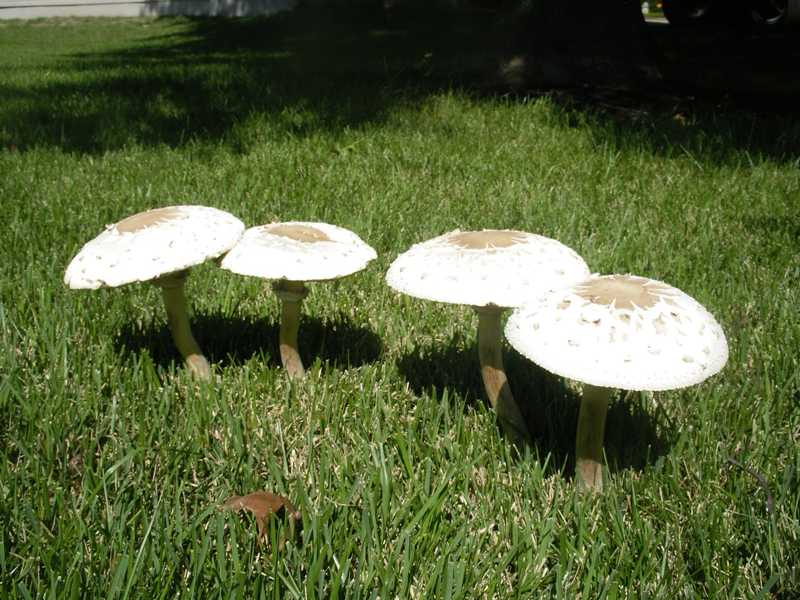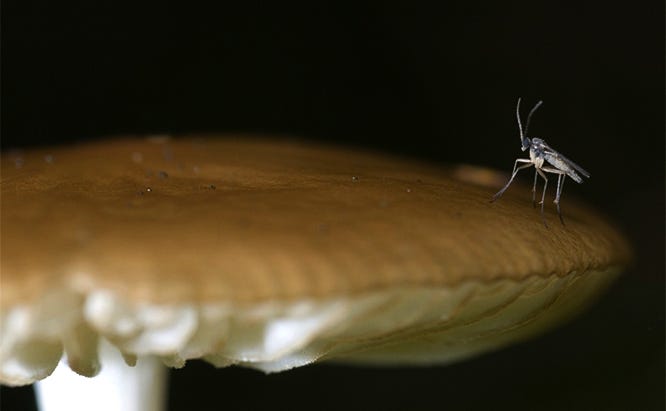Identify common mushroom pests by inspecting for small insects, discoloration, and damaged mushroom caps. Check for slimy trails and fungal gnats.
Mushroom cultivation can be rewarding, but pests can pose significant challenges. Common pests include fungal gnats, mites, and slugs. These pests can damage mushroom crops, leading to reduced yields and quality. Fungal gnats are small, dark insects that hover around mushrooms.
Mites are tiny, often invisible to the naked eye but cause discoloration. Slugs leave slimy trails and chew holes in mushroom caps. Early identification and control of these pests are crucial for maintaining healthy mushroom crops. Regular monitoring and proper hygiene can help prevent infestations. By staying vigilant, growers can ensure their mushrooms remain pest-free and thrive.

Credit: www.missouribotanicalgarden.org
Introduction To Mushroom Pests
Mushroom cultivation can be rewarding. Yet, it faces many challenges. One of the biggest is dealing with mushroom pests. These tiny invaders can destroy your crops. Knowing how to identify them is crucial.
Importance Of Identification
Identifying mushroom pests is very important. It helps you act quickly. This can save your crop from damage. It also helps you understand what type of pest you are dealing with. Different pests require different solutions. Early identification can make all the difference.
Below are some common signs of mushroom pests:
-
- Holes in mushroom caps
- Discolored or decaying mushrooms
- Presence of small insects or larvae
Impact On Mushroom Cultivation
Pests can have a severe impact on mushroom cultivation. They can ruin entire batches. This results in wasted time and money. Some pests spread diseases. This can make the problem worse. Here is a table showing common pests and their impact:
| Pest | Impact |
|---|---|
| Fungus Gnats | Larvae eat mushroom mycelium |
| Springtails | Feed on mushroom roots |
| Trichoderma | Competes for nutrients, causing decay |
Understanding the impact of these pests can help you prepare. It also highlights the need for regular checks. Always be on the lookout for signs of pests. Early detection is key to a healthy mushroom crop.

Credit: www.saferbrand.com
Types Of Mushroom Pests
Mushroom farming can be a rewarding endeavor. Yet, it comes with challenges. One major challenge is dealing with pests. Identifying these pests is crucial. Below, we explore the types of mushroom pests you might encounter.
Insects
Insects are common mushroom pests. They can damage your crop. Here are some of the most common ones:
-
- Fungus Gnats: These tiny flies lay eggs in the soil.
- Springtails: They are small and white, often found in humid areas.
- Sciarid Flies: These flies harm the mushroom mycelium.
Mites
Mites are another significant pest. They are tiny and hard to see. Here are some types:
-
- Grain Mites: These mites feed on mushroom spores.
- Red Mites: They suck the sap from mushroom stems.
Fungi
Fungi can also be pests in mushroom farming. They compete with your mushrooms. The following fungi are common pests:
-
- Trichoderma: It appears as green mold on the substrate.
- Cobweb Mold: It looks like a web and spreads quickly.
- Verticillium: This fungus causes brown spots on mushrooms.
Identifying these pests helps in managing them. Use this guide to protect your mushroom crop.
Identifying Insect Pests
Identifying insect pests in your mushroom garden is crucial. These pests can damage your mushrooms. They can also spread diseases. Knowing how to spot these insects will save your crop. This guide will help you identify common insect pests.
Common Insect Species
Several insects can invade mushroom gardens. Here are some common ones:
-
- Mushroom Flies: Small, black flies that lay eggs on mushrooms.
- Fungus Gnats: Tiny, dark-winged insects attracted to moisture.
- Springtails: Small, white or gray insects that jump when disturbed.
- Phorid Flies: Also known as humpbacked flies, they are slow-moving.
Signs Of Infestation
Look for these signs to spot an infestation:
-
- Visible Insects: You might see flies or gnats around mushrooms.
- Larvae: Check for tiny, white larvae on the mushroom caps.
- Discolored Spots: Mushrooms may have brown or yellow spots.
- Damaged Caps: Insects might chew holes in the mushroom caps.
Early detection of pests helps protect your mushrooms. Regularly inspect your garden. Use this guide to identify and manage pests effectively.
Mite Infestations
Mite infestations are a common problem for mushroom growers. These tiny pests can wreak havoc on your crop. They are difficult to see with the naked eye. But their damage is often noticeable.
Types Of Mites
There are several types of mites that can affect mushrooms. Here are the most common ones:
-
- Spider Mites: These mites spin webs around mushroom caps.
- Bulb Mites: These mites burrow into the mushroom stems.
- Grain Mites: These mites thrive in moist environments.
Detection Methods
Detecting mites early can save your mushroom crop. Here are some methods to identify mite infestations:
-
- Use a magnifying glass to inspect the mushroom surfaces.
- Look for tiny moving spots on the mushrooms.
- Check for webbing around the mushroom caps.
- Inspect the soil and compost for signs of mites.
- Use sticky traps to capture and identify mites.
Regularly monitor your mushroom growing area. Early detection is key to managing mite infestations.
Table of Common Mite Signs:
| Type of Mite | Common Signs |
|---|---|
| Spider Mites | Webbing on mushroom caps |
| Bulb Mites | Burrows in mushroom stems |
| Grain Mites | Presence in moist environments |
Fungal Contaminants
Identifying common mushroom pests is crucial for any mushroom grower. One of the most challenging issues is dealing with fungal contaminants. These pests can destroy your crop quickly. Knowing the signs and types of fungal pests can save your harvest.
Common Fungal Pests
Several fungal pests can invade your mushroom farm. Here are some of the most common ones:
-
- Trichoderma – This green mold is highly aggressive.
- Penicillium – Often appears as blue or green patches.
- Aspergillus – Known for its black or yellow spores.
- Mucor – Appears as a white, fluffy growth.
Symptoms Of Contamination
Identifying symptoms early can help manage fungal contamination. Look for these signs:
-
- Discoloration – Watch for unusual colors on the substrate.
- Odor – Contaminated mushrooms often smell foul.
- Texture – Infected areas may feel slimy or mushy.
- Growth Patterns – Irregular growth can indicate a problem.
| Fungal Pest | Color | Texture |
|---|---|---|
| Trichoderma | Green | Velvety |
| Penicillium | Blue/Green | Powdery |
| Aspergillus | Black/Yellow | Dry |
| Mucor | White | Fluffy |
By understanding these symptoms and pests, you can keep your mushrooms healthy. Always inspect your crop regularly. Early detection is key to preventing widespread damage.
Preventive Measures
Identifying common mushroom pests is crucial for maintaining healthy crops. Preventive measures can help keep these pests at bay. Here, we discuss essential steps for effective pest prevention.
Hygiene Practices
Maintaining excellent hygiene is vital in mushroom cultivation. Always clean tools and surfaces to prevent contamination. Follow these steps:
-
- Use sanitized tools to handle mushrooms.
- Regularly clean growing areas with disinfectants.
- Dispose of infected mushrooms immediately.
- Wear clean gloves when handling mushrooms.
Keeping your environment clean reduces the risk of pests and diseases. Proper hygiene practices are the first line of defense.
Environmental Controls
Control the environment to limit pest infestation. Monitoring and adjusting conditions can make a difference. Consider these factors:
| Factor | Ideal Condition |
|---|---|
| Temperature | Maintain within recommended range for mushroom type. |
| Humidity | Keep humidity levels stable and within optimal range. |
| Ventilation | Ensure proper airflow to prevent mold growth. |
Regularly monitor environmental conditions to prevent favorable conditions for pests. Use humidity and temperature controls to maintain an ideal environment.
Proper ventilation helps to avoid the buildup of moisture which attracts pests. Implement environmental controls as a proactive measure.
Treatment Options
Dealing with mushroom pests can be challenging. Various treatment options help keep your mushrooms healthy. Two major methods include chemical treatments and biological controls.
Chemical Treatments
Chemical treatments can be effective. They involve using pesticides to eliminate pests. Here are some common chemical treatments:
-
- Fungicides: These target fungal pests. Apply as directed on the label.
- Insecticides: These help control insect pests. Follow safety guidelines strictly.
- Miticides: These are used for mite infestations. Use sparingly to avoid resistance.
Always wear protective gear. Read all instructions before applying chemicals. Ensure proper ventilation in the growing area.
Biological Controls
Biological controls use natural predators to manage pests. This method is eco-friendly and sustainable. Here are some biological controls:
-
- Predatory Insects: Ladybugs eat aphids. Introduce them to your growing area.
- Nematodes: These microscopic worms target soil pests. Apply them to the soil.
- Beneficial Fungi: Some fungi can outcompete harmful pests. These are available in commercial products.
Biological controls often take longer to show results. They do not harm the environment. Combining these methods can provide effective pest management.

Credit: ohioline.osu.edu
Monitoring And Maintenance
Effective Monitoring and Maintenance are essential for healthy mushroom growth. By regularly checking your mushroom farm, you can spot pests early. This helps you take action before they cause damage. Regular inspections and record keeping are key practices in maintaining a pest-free environment.
Regular Inspections
Inspect your mushroom farm at least once a week. Look for signs of pests like holes in mushrooms or droppings. Check the soil and growing medium for any unusual activity. Use a flashlight to see better in dark areas. Make sure to inspect the underside of mushroom caps. Pests often hide there.
Keep an eye out for mites, flies, and slugs. They are common mushroom pests. Use a magnifying glass to spot tiny pests. Early detection can save your crop. If you find pests, act quickly to remove them.
Record Keeping
Maintain a logbook of your inspections. Note down the date, time, and findings of each inspection. Record the types of pests found and the number of affected mushrooms. This helps you track pest activity over time. Use a simple table to keep records organized:
| Date | Inspection Time | Pests Found | Number of Affected Mushrooms |
|---|---|---|---|
| 01/01/2023 | 10:00 AM | Slugs | 5 |
| 08/01/2023 | 10:00 AM | Mites | 3 |
Review your logbook regularly. Look for patterns in pest activity. This helps you understand when and where pests appear. Take action based on your records to prevent future infestations.
By doing regular inspections and keeping detailed records, you can maintain a healthy mushroom farm. These practices help you identify and manage common mushroom pests effectively.
Frequently Asked Questions
How Do You Identify Mushroom Contamination?
Identify mushroom contamination by checking for unusual colors, foul odors, slimy texture, or fuzzy growth. Look for black, green, or pink spots.
How Do You Get Rid Of Mushroom Bugs?
Remove mushroom bugs by keeping the area dry. Use insecticidal soap or neem oil for treatment. Clean up any decaying organic matter. Ensure good air circulation. Maintain healthy soil conditions.
What Are The Maggots In My Mushroom Grow Kit?
Maggots in your mushroom grow kit are likely larvae of fungus gnats. They thrive in moist environments. Remove them promptly to protect your mushrooms.
How Do You Know If Mushroom Spawn Is Bad?
Mushroom spawn is bad if it has a foul odor, mold growth, or discoloration. Healthy spawn appears white and smells earthy.
How Can I Spot Mushroom Pests?
Look for bite marks, slime trails, and discoloration. These are common signs of mushroom pests.
Conclusion
Recognizing common mushroom pests is crucial for healthy growth. Use these tips to spot and manage them effectively. Regular checks and prompt actions ensure your mushrooms thrive. Stay vigilant and maintain optimal conditions to prevent infestations. Happy mushroom growing!
